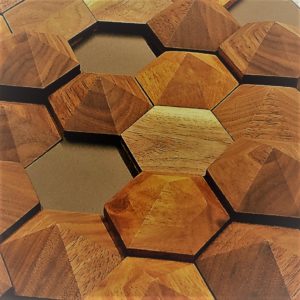There’s no such thing as small talk with bee guy Bob Bailey. I hesitate to label him as a “bee guardian,” because it’s way beyond that for Bob. In the course of our friendship, I’ve come to see that bees are his metaphor for living and being.
His personal space speaks of that relationship— his last gardens surrounded several hives and literally, a fresh-water spring burbling up from the earth. Right there. In the middle of his yard. “The girls” were at ease in their territory, silver blurs filling the air like a land-locked hatch. Against blue skies and green vegetable beds, their small bodies channeled sunlight, their legs dangled, heavy with their ochre baskets of pollen. The blossoms all around, planted just for those hard worker-girls, were crawling with myriad species, more than just bees. It was an abundant, halcyonic Eden. You could see this is Bob’s love.
As a gardener, I’ve been curious and wishful for bees in my world, too. There’s something about their circle of life— pollination, sunlight, chlorophyll and sustenance in all of its purity. How could you not want to mainline that everyday?
I’ve been nagging Bob for feral bees ever since. Feral, as in wild, free ranging bees calling their own shots.

Artwork by David Kodama and Liz Heller
“Feral bees are not a choice for you. They choose you,” he says, with a direct stare. “Feral bees are something that moves into your home on their own. It tells a lot about that individual that they choose. If you get a swarm of bees— we can call that feral— those would be a good candidate to have in your yard to nurture.”
However, despite being chosen, homeowners frequently reach out to people like Bob to pull colonies from their homes.
“People think they do damage,” he says, “Honey bees are not causing any damage to your house.”
Knowing how Bob feels about bees, hive collapse and commercial practices around bees, I ask him, “When you show up for a removal and first see the bees, what is your initial response?”
Without hesitation: “Leave ‘em.”
“Do you ever see rot, or seepage, or ooze?” I ask.
“Honey, sometimes. It might be coming out of the walls. Honey’s pure. It’s a sealer, like putting oil on a tool. It’s a preservative. The propolis is anti-fungal, antimicrobial. It protects,” he answers.
Many beekeepers, opening hives in the spring, will find propolized mice. The propolis, gathered from the bud scales of trees— you know that brown sticky stuff that ruins your shorts when you sit on it? Bees collect propolis for hive management, sealing off anything undesirable, whether it’s wind or invaders.
“If you were to speak your mind to a homeowner,” I ask, “that has hired you to remove a colony, what would you say if you could speak forwardly about it?”
“Let’s try and allow the bees to stay there,” he says in a softer voice, “so they can continue to grow as a species. In this valley especially what they’re using these homes for is a way to perpetuate themselves,” he explains. “The natural cavities in the trees in this valley are not large enough— cottonwoods, possibly. The trees are not large enough or proficient in quantity to accommodate the swarm populations of this valley. They need cavities about the size of a 5-gallon bucket. Large enough conifers are often blown over or cut down. Bees have evolved enough to know if they colonize a fallen log, bears, raccoons, anything else that walks along would have at them. It’s also our climate and our elevation that compels bees to colonize homes.”
“Is it possible for bee lovers to incorporate bee friendly cavities when they build or renovate their homes?” I ask hopefully.
“Oh, absolutely. It’s done all the time, but through poor building practices!” he says. “But yes, you could design the soffit to accommodate them. Seventy-five percent of the colonies I take out are in a soffit.”
“Why don’t bee guardians promote that as a movement?” I ask. It seems brilliant to me, anyway. I will, when I build.
Because when I think of bees, I honest to gosh get all dreamy. I have a memory of lying on the ground one summer, the tendrils of flowering vines wending all about, engulfing the hive. The bees were scrambling and lolling on the sprays of blooms, coming and going at the hive landing. The air vibrated in wing beats. Staring up at the sky in a luscious meditative state— a world of pink and gold bliss, peaked at through eyelashes and half closed lids, I remember total peace. Mesmerized by their reality. It’s quite magical. I want that for our family, to be dialed into that every day. I don’t need their honey. I don’t want to harass them. I just want to be with them, like my chickens, my daughter, the birds in our trees and the neighborhood cats, the deer that hang out with us.

Artwork by David Kodama & Liz Heller
“People are afraid of bees,” says Bob. “They want ownership of them. I hear it all the time, ‘My bees, my bees,’ and I tell them over and over, ‘They’re not your bees. You don’t own them.’ Once you take ownership of anything in life,” he philosophizes, “it will leave you. If you take ownership of a relationship between a man and a woman, someone’s gonna leave. Stop taking ownership of anything in life.”
So much for ‘my own’ ferals.
Bob has several of his own hives and manages them for many others. But ferals have a special spot in that ol’ ticker of his.
“I’m following bees in this valley that the only way they could survive in this valley is by using homes to get into. I’ve followed colonies of bees along ______ Creek, and now they’re at 8000 feet! And they’re thriving! I have an infrared camera that I’ve used to see their heat. It’s a massive colony. And when they swarm, the only way that they’ve traveled up through the valley is using people’s homes to get to that point. There’s never been a tree in that area big enough to support a feral colony.”
This is exceptional news. I remember originally that he was called in to remove it.
“I started explaining to them about what part they held in this valley by allowing those bees to stay there. I got a phone call from them last week— they don’t live here fulltime— ‘How are the bees doing?’”
The valley’s bees are a phenological emotional map of how Bob experiences the Roaring Fork watershed. He’s keyed into them 24/7 and they’re so familiar to him, his view of the valley is in terms of its feral colonies. He doesn’t often reveal locations; he doesn’t want them bothered. Bob Bailey is definitely way beyond ‘bee guardian.’
“It’s kinda like picking mushrooms,” he says, intent on keeping local ferals free ranging.

A work in progress for David Kodama of Kenichi Woodworking and ceramicist Liz Heller for Carbondale Clay Center’s “Sticks + Stoneware,” throughout the month of May

